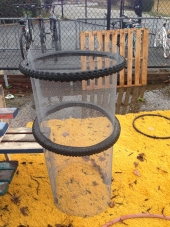Now I'm going to have to learn how to bookmark permies posts--especially since I got a good harvest this year. I've said potatoes are the number one crop to grow because they're fairly easy to grow and store, nutritious and maybe more versatile than any other vegetable...and here we have a massive load of new recipes. Barbara Manning alone contributed so much information, including details and correct spelling, that I hope she got bushels of apples for her posts.
I have a couple tips, maybe off topic slightly--the first one is what I did yesterday and this morning. I store most of my potatoes in a root cellar. They're harvested as early as early July, when it's 70 degrees F in there...far above ideal temperature. They seem to mostly keep well despite this, but nonetheless I want to get the temperature down as soon as I can. It was supposed to go down to 43 last night (actually 45) so I hauled all my potatoes a short distance to the greenhouse overnight and left the rootcellar door open (have to remove all contents so I'm not inviting mice into the rootcellar). I stopped on the way to spill each vessel onto the ground to check for rot, which was due anyway.
On recipes, I don't have much to offer other than half baking whole potatoes, than scooping out a lot of the insides to mix with say fried burger and onions, garlic, maybe peppers, then briefly bake again.
But I will mention one of my two vegan recipes: make mashed potatoes the usual way, and meanwhile fry a whole pound of crumbled tofu, onions and garlic, and mushrooms if you've got them, the whole time the potatoes are boiling. In a small cast iron frying pan (that's what I use anyway) put in a mixture of 1/4 cup flour and 1/2 cup of nutritional yeast into a hot pan. After a minute of so, when you smell nuttiness, add a small splash of oil and 1 1/2 cups of water, and whisk to remove lumps. When it begins to bubble, add 2 or 3 tablespoons of tamari (you could probably use soy sauce or salt). Whisk most of the time until it has thickened adequately, then grate a little pepper on top, turn off the heat, and cover. Meanwhile steam some vegetable--green beans and greens both work well. Serve the mashed potatoes topped with the fried tofu mixture, topped with the gravy, and the veg on the side or mixed in.
Another one is potato chowder--I boil chopped potatoes with grated carrots (if you just chop the carrots they won't be done when the potatoes are.) Meanwhile I saute onions, garlic, a little sausage and maybe bok choy or chard stems. When the potatoes are mashable, I do that, possibly using an immersion blender if the potatoes are peeled, stir in the fried stuff, then if the texture is right (if it isn't necessary to boil off excess water) I add some milk and a bunch of grated cheese, usually cheddar. Serve with thick slices of buttered bread.










